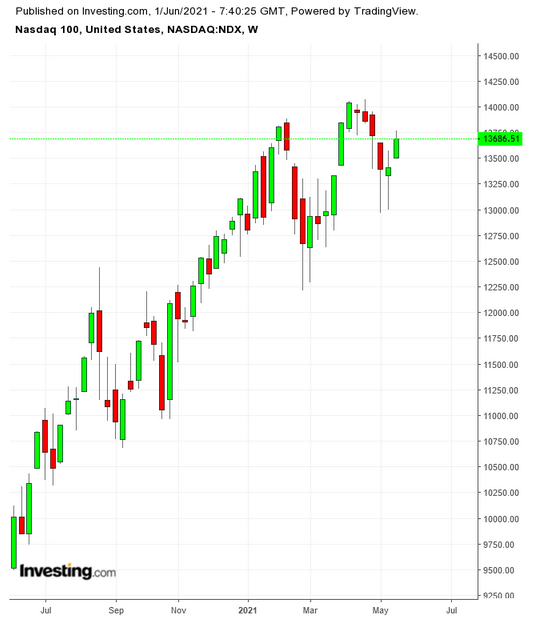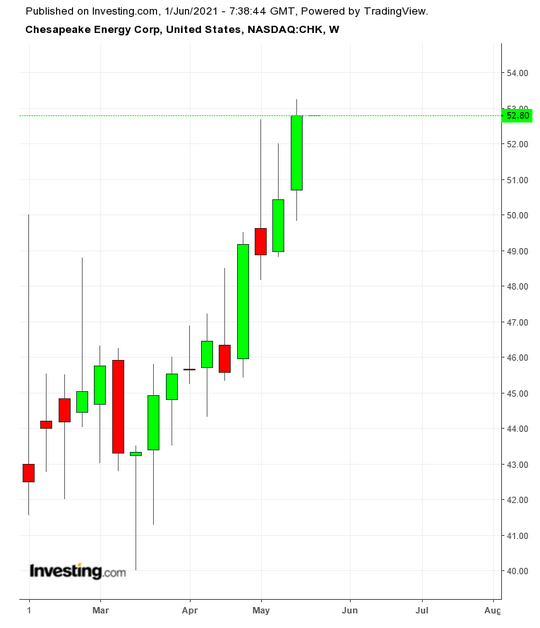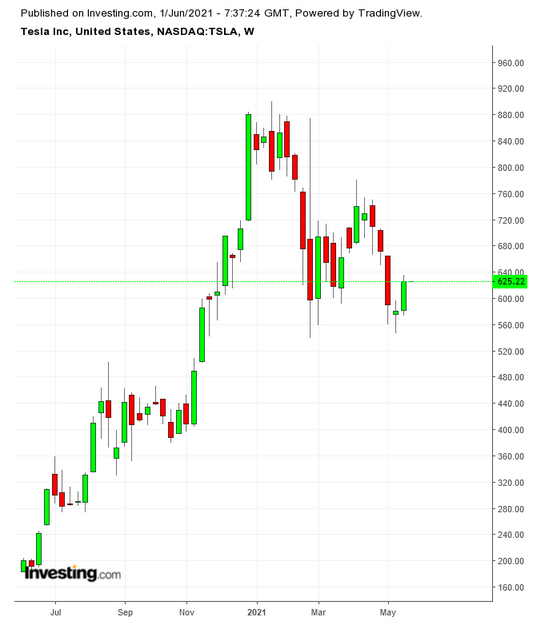When trading opened at the beginning of May, Wall Street seemed almost smugly optimistic.
The long-awaited economic recovery was unfolding nicely. The jobs market appeared to be improving. Home construction was booming, and the COVID-19 pandemic was showing signs of fading.
But asset markets overall delivered only modest, nervous results during the past month, because investors kept getting roiled by events beyond almost anyone's control.
Recurring worries included fears that maybe a new bout of inflation was erupting; or labor shortages were starting to be a problem. Throughout May, stocks seemed to struggle after hitting new highs—even after some of those new highs had been reached in March—and equities started looking a bit overbought.
There were also a few geopolitcal ructions: a ransomware attack on one of the most important U.S. gasoline pipelines had a number of people hoarding gasoline; an eruption of violence in the Middle East led to a short, sharp war, increasing tensions with Russia and China and generating all sorts of political stress.
By the end of May, the inflation worries seemed to be waning. But not much else had changed.
And so, as we enter the month of June, the equity market has seemed to have settled into a holding pattern.
How the numbers break down
Over the course of May, the S&P 500 stumbled to a 0.55% gain. Though admittedly its fourth straight monthly gain after a dip in January, the index rose 5.24% in April after a 4.2% gain in March. So results for the broad benchmark were anemic...at best.
The outcome for other major US indices was mixed. The Dow Jones Industrials moved up 1.93% for May, but the tech-heavy NASDAQ Composite slipped 1.53%.

The NASDAQ 100 fell 1.26% and hasn't hit a new closing high since it touched 14,041.91 on Apr. 16.
Outside the United States, results were similar. The Standard & Poor's Global Broad Market Index, which tracks stocks across some 50 markets, added just 1.29%.
Interest rates remain low
Interest rates and bond yields fell after rising in March and again in the second half of April.
The 10-year Treasury yield ended at 1.581%, down from 1.626% on Apr. 30. The yield had moved higher in the first quarter, peaking at 1.74% on Mar. 31 as worries mounted about nascent inflation.
The 10-year yield hasn't finished above 2% since August 2019 and stood at 2.467% when Donald Trump became president.
Energy prices continue higher
Oil prices prices, meanwhile, moved higher, with West Texas Intermediate crude ending at $66.32 a barrel, up 4.3% for the month and 36.7% for the year.
Prices crashed to negative levels in March 2020 when the COVID-19 pandemic caused many markets to melt down.
The WTI price is at the same level it was during mid-2019, before Saudi Arabia and Russia got into an oil-price war.
Rising prices were good for energy stocks (especially oil services stocks) as oil-and-gas drillers started to work again.

Gas producer Chesapeake Energy (NYSE:CHK) ended the month up 15.87%. Schlumberger (NYSE:SLB) added 15.8%. Exxon Mobil (NYSE:XOM) was up just 1.97%.
The Baker Hughes weekly rig count was 455 on Friday, up 87% from the August 2020 bottom and up 19 out of the last 21 weeks. The rig count is off nearly 58% from the 1,080 count at the end of 2018 and -78% from the rig count's 2008 peak.
A move to value stocks as vaccinations lead to growing optimism
What should have boosted stocks in May was the good news about continuing progress in vaccinating as many Americans against COVID-19. More innoculations resulted in fewer cases and even fewer deaths.
Which meant the U.S. economy could reopen more rapidly.
As the Memorial Day weekend began, roads and airports, restaurants and movie theaters saw big customer increases and a willingness by consumers to simply spend on things other than the basics.
The equity market beneficieries: companies involved in accelerating the recovery's momentum. These included steel makers, auto manufacturers, metal miners, energy providers and traditional financial institutions.
For the S&P 500, that meant gains for such stocks such as cybersecurity firm NortonLifeLock (NASDAQ:NLOK), +28%; Ford Motor (NYSE:F), +25.9; steel maker Nucor (NYSE:NUE), +24.7%; and packaging company Sealed Air (NYSE:SEE) +15.1%.
Some of last year's high flyers were among the losers, including crafts site Etsy (NASDAQ:ETSY), off 17%, Dollar Tree (NASDAQ:DLTR), down 15.1%; and used vehicle retailer CarMax (NYSE:KMX), down 13.6%.

Perhaps the most visible decliner was Tesla (NASDAQ:TSLA), down 11.9% for the month and off nearly 31% after peaking at $900 on Jan. 25. The company's losses also weighed on the the results for the S&P 500, the NASDAQ and the NASDAQ 100, all indices on which the EV carmaker is listed.
The top performers among the Dow industrials were: chemical-maker Dow (NYSE:DOW), up 9.47%; financial stalwarts JPMorgan Chase (NYSE:JPM), up 6.78%, and Goldman Sachs (NYSE:GS), up 6.76%; construction and mining equipment manufacturer Caterpillar (NYSE:CAT), 5.69%, and aviation giant Boeing (NYSE:BA), up 5.42%.
The losers were Apple (NASDAQ:AAPL), down 5.2%, Walt Disney (NYSE:DIS), down 3.96%), Visa (NYSE:V), down 2.68%, Verizon Communications (NYSE:VZ), down 2.25% and Home Depot (NYSE:HD), down 1.47%.
Apple and Home Depot had been among the Dow's top April performers.
The problem of wood and inflation
The combination of optimism alongside the stresses of the pandemic produced some unintended consequences. The most visible is probably the rapidly accelerating price of lumber, which has tripled in the past year.
Many analysts blame the price jump on overwhelming demand for housing and way-too-little supply. Home prices in big metro areas were up 13.25% in March from a year earlier, said the S&P CoreLogic Case-Shiller National Home Price Index.
The demand picture is too simple, said Shawn Kelly, editor of Random Lengths, a Eugene, Ore., company that tracks prices of lumber and related wood products like plywood.
Yes, people are moving out, he said in an interview, but demand for wood and the like for use in home remodeling and renovation projects is just about as big. Plus, the Federal Reserve's low-interest-rate policy is accelerating home-buying pressures.
But the lumber market may be peaking.

Lumber futures trading shows a 21% drop from $1,670.50 per 1,000 board feet to $1,303.50.
Kelly said Random Lengths' widely followed composite index fell from $1,514 to $1,494 per 1,000 board feet, the first decline in 18 weeks.
One final point: A number of U.S. companies believe that tariffs imposed on China and European countries by the Trump administration are adding to price pressures and ought to be removed.
May Shockers
Here are some of the crazy things that kept stocks overall in check in May.
Tesla. Tesla's woes were due to market and financial pressures. First, the shares hit $900.40 on Jan. 25, and many investors decided to cash in their profits.. Many investors are still sitting on the big gains though—the shares ended May up 647% from the end of 2019.
The second problem for the Palo Alto, California-based EV manufacturer was more operational. Its Q1 results were not as robust as initially thought. $101 million of its first-quarter net income came from selling some of the company's Bitcoin holdings. Income was also boosted by sales of regulatory credits to other manufacturers to meet emissions mandates totaled $518 million, which flows to the bottom line. Also weighing on shares, a fatal crash involving someone using the vehicle's self-driving function and delays in getting a new plant opened in Berlin have cut into investor enthusiasm.
ARK Innovation ETF. Tesla's results pressured the performance of the ARK Innovation ETF (NYSE:ARKK), a fund managed by star money manager Cathie Wood and and a marquee fund for her company, ARK Investment Management. The ETF was up nearly 149% in 2020 as it bet on companies that her firm expected to be "the leaders, enablers, and beneficiaries of disruptive innovation."
Tesla, however, represented—and still represents—more than 10.1% of assets within the fund. So, TSLA was a drag on ARKK in May. The ETF's price was off 6.67% and its total return was down 10%. From its February peak, the ETF price is off 28.4%.
Cryptocurrencies. Bitcoin and all digitial currencies may be wearing out their welcome. One issue is the tremendous computer power needed to mine one Bitcoin or many of its peers. According to the Digiconomist, all Bitcoin mining operations consume more power in a year than the entire population of the Netherlands.
Then there's the wild volatility. Bitcoin was up 24.7% for the year as of Friday but DOWN 44.3% from its peak of $64,788 on Apr.14.
Exxon and activist shareholders. Exxon Mobil investors and big corporations generally were astounded when activist shareholders who want the oil supermajor to include climate change in corporate planning won at least two board seats.
Exxon has long argued that global oil demand will grow in tandem with the earth's population. But the small activist investor Engine No. 1 argued in a $65 million campaign that the heyday of fossil fuels is over as public concerns rise over carbon emissions and global warming.
Exxon was not alone in being blindsided. Chevron (NYSE:CVX) shareholders voted for a proposal to reduce emissions. Royal Dutch Shell (NYSE:RDSa) was ordered by a Dutch court to slash its emissions harder and faster than planned. The company is appealing.
If there was any solace, none of the energy stocks were affected much. Of course, they had already been hit hard as oil demand was slammed by COVID-19.
What's ahead
The conditions that created the optimism for May have not gone away and should give markets support in June. The pandemic appears to be fading. Investors are betting more stimulus is coming from the Biden Administration.
That should set off a lot of pent-up spending on everything from going out to dinner or going to Paris.
Most importantly, the Federal Reserve has argued recent inflationary pressures (prices for lumber, oil and gasoline, food and the like) should fade and won't do much about interest rates until next year. The policy could change, however, if, say, Friday's jobs report is stronger than the surprisingly weak report for April.
Housing pressures, however, may not dissipate unless bosses start telling workers that coming into the office is required.
The biggest risks may be political. First, domestic politics are becoming increasingly tense as many Republicans continue to argue the 2020 election was stolen from Donald Trump. Efforts to make voting harder will add to the fire.
Geopolitics should be minded. Israel and its neighbors in Gaza just had a nasty outbreak of violence. The West was outraged when the government of Belarus forced a commercial airliner to land to forcibly arrest a dissident journalist.
Tensions between the United States, Russia and China are growing, though Joe Biden will meet with Vladimir Putin in June. The Chinese relations may worsen because of Biden Administration demands for greater clarity on the origins of the COVID-19 virus.
